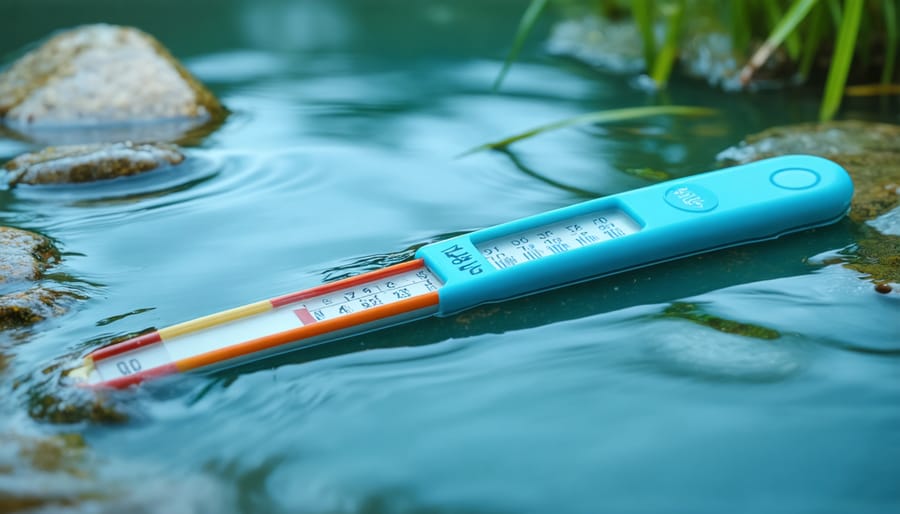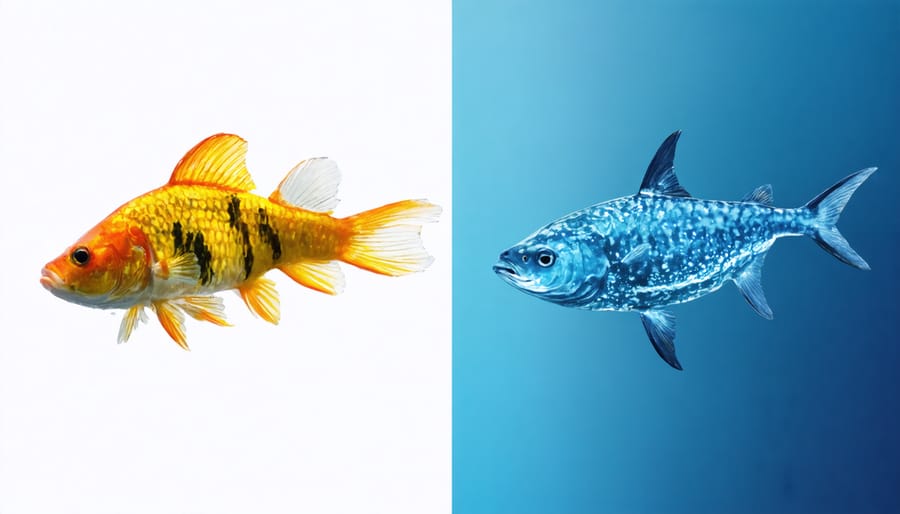
Protect Your Pond: How Climate Changes Affect Fish Health and Disease
Climate fluctuations dramatically impact pond ecosystems, affecting everything from water quality to fish health. Regular monitoring of water temperature patterns helps predict and prevent potential issues before they escalate into major problems. Understanding these climate-driven changes is essential for responsible aquatic management, particularly as seasonal shifts become more unpredictable.
Ponds respond sensitively to environmental changes, serving as miniature ecosystems that reflect broader climate patterns. During warmer periods, increased sunlight and higher temperatures can accelerate algae growth and reduce oxygen levels, while colder seasons bring different challenges like ice formation and slower biological processes. These variations directly influence pond inhabitants, from beneficial bacteria to fish populations, creating a delicate balance that requires careful attention.
For pond owners and enthusiasts, recognizing these climate-related patterns enables better preparation and maintenance strategies. Whether it’s adjusting aeration systems during heat waves or modifying feeding schedules during temperature drops, understanding climate impacts helps maintain healthy, vibrant pond environments year-round. This knowledge forms the foundation for successful pond management and ensures long-term ecosystem stability.
How Temperature Swings Impact Your Pond’s Health
The Critical Temperature Zones
Temperature plays a crucial role in maintaining a healthy pond ecosystem. Most pond life thrives when water temperatures stay between 68°F and 75°F (20-24°C). This sweet spot provides optimal conditions for fish activity, plant growth, and beneficial bacteria reproduction.
When temperatures climb above 80°F (27°C), pond life begins to face challenges. Warm water holds less oxygen, putting stress on fish and other aquatic creatures. During these periods, you might notice your fish becoming less active or gasping at the surface. Water temperatures above 85°F (29°C) can be dangerous, potentially leading to fish stress and algae blooms.
On the cooler end, most pond life slows down dramatically when temperatures drop below 50°F (10°C). Fish become less active and eat less frequently, while plants enter dormancy. While brief dips below freezing won’t harm hardy species, extended periods of ice coverage require special attention to maintain gas exchange.
To monitor these critical zones, invest in a reliable pond thermometer and check it regularly. Understanding your pond’s temperature patterns throughout the seasons helps you anticipate and respond to potential problems before they become serious issues. Remember that shallow ponds are more susceptible to temperature fluctuations than deeper ones.

Seasonal Changes and Risk Periods
Ponds face distinct challenges throughout the year, with each season bringing its own set of risks and considerations. Spring typically marks the start of increased algae growth as temperatures rise and sunlight becomes more intense. This period requires careful monitoring of water quality as dormant organisms become active again.
Summer presents the highest risk for pond health issues. Extended hot spells can lead to reduced oxygen levels, especially during night hours when plants switch from producing to consuming oxygen. Heavy rainfall events can also wash excess nutrients into the pond, potentially triggering algal blooms.
Fall brings unique challenges with decomposing leaves and plant matter. This organic material can sink to the bottom, affecting water quality and potentially leading to harmful gas buildup under winter ice. It’s crucial to remove fallen leaves before they sink.
Winter poses risks of ice cover preventing gas exchange between water and air. Partial freezing can concentrate dissolved substances in the remaining liquid water, potentially stressing pond life. Sudden temperature swings during late winter and early spring can also disturb the pond’s natural balance.
Weather patterns like prolonged droughts or excessive rainfall periods require extra attention, as they can dramatically affect water levels and quality. Being aware of these seasonal patterns helps in planning preventive measures and maintaining a healthy pond environment year-round.

Common Climate-Related Diseases in Ponds
Warm Weather Threats
As temperatures rise during warmer months, ponds become more susceptible to various emerging pond pathogens that can affect both fish and plants. One of the most common issues is columnaris disease, which thrives in waters above 68°F (20°C) and can cause cotton-like growths on fish. Warm water also encourages the growth of harmful bacteria and parasites, as these organisms multiply more rapidly in higher temperatures.
Algae blooms become particularly problematic during warm weather, as increased sunlight and warmer temperatures create perfect conditions for explosive growth. These blooms can deplete oxygen levels, especially at night, putting stress on fish and other aquatic life. Additionally, some species of blue-green algae can produce toxins that are harmful to pets and humans.
Fish are especially vulnerable during warm periods because higher temperatures reduce dissolved oxygen levels in the water. This stress can weaken their immune systems, making them more susceptible to infections and parasitic attacks. Common warm-weather diseases include ich (white spot disease) and fungal infections, which can spread quickly through a pond population if left unchecked.
To protect your pond inhabitants, maintain proper aeration, monitor water quality regularly, and consider adding shade plants or floating covers to help regulate temperature. Early detection and intervention are key to preventing these warm weather threats from becoming serious problems.
Cold Weather Concerns
When temperatures drop, ponds face several unique health challenges that require careful attention. The most immediate concern is ice formation, which can trap harmful gases beneath the surface and prevent oxygen exchange. This can lead to winter kill, where fish and other aquatic life struggle to survive due to poor water quality.
Pond inhabitants become particularly vulnerable during cold spells. Fish metabolism slows dramatically, weakening their immune systems and making them more susceptible to parasites and bacterial infections. Common cold-weather ailments include winter fungus, which appears as cotton-like growths on fish, and bacterial gill disease, which can be fatal if left untreated.
Plant life also suffers during cold weather. Dying vegetation releases nutrients into the water, potentially leading to algae blooms when temperatures rise again. Additionally, decomposing plant matter consumes valuable oxygen that fish need to survive the winter months.
To protect your pond’s ecosystem during cold weather, maintain a small ice-free area using a floating de-icer or aerator. Never break ice by hitting it, as the shock waves can harm fish. Remove dead plant material before winter sets in, and consider using beneficial bacteria products designed for cold water to help maintain water quality.
Monitor water parameters regularly during winter, as problems can develop quickly when temperatures fluctuate. Being proactive about cold weather concerns will help ensure your pond emerges healthy when spring arrives.
Climate-Smart Pond Management
Prevention Strategies
Taking proactive steps to protect your pond from climate-related issues is crucial for maintaining a healthy aquatic ecosystem. Start by installing a reliable aeration system, which helps maintain consistent oxygen levels regardless of temperature fluctuations. Consider adding floating plants that provide natural shade, helping to keep your pond pristine and regulate water temperature during hot spells.
Regular water testing is essential – invest in a good testing kit and monitor parameters like pH, ammonia, and dissolved oxygen weekly. Create a seasonal maintenance schedule that includes clearing debris, trimming plants, and checking equipment. During extreme weather events, have backup power sources ready for crucial equipment like aerators and filters.
Installing a pond thermometer helps you track temperature changes and respond accordingly. Consider adding deeper sections (at least 2-3 feet) to your pond, providing fish with cooler refuge areas during heat waves. Use beneficial bacteria products regularly to maintain biological balance, especially during temperature transitions.
Remember to maintain adequate water levels, as evaporation increases during warmer periods. Installing an automatic top-up system can help manage water levels effortlessly. Finally, develop an emergency action plan for extreme weather events, including having spare equipment and knowing when to add shade structures or emergency aeration.
Monitoring Systems
Keeping track of your pond’s health doesn’t have to be complicated. With the right monitoring systems in place, you can easily spot potential problems before they become serious issues. A basic water testing kit is essential for checking important parameters like pH, ammonia, and dissolved oxygen levels. These kits are available at most garden centers and are simple to use with color-coded charts.
Temperature monitoring is equally important. A floating pond thermometer gives you accurate readings of water temperature throughout different depths. For tech-savvy pond owners, digital monitoring systems can provide real-time data right to your smartphone, alerting you to any concerning changes.
Don’t forget to keep an eye on water levels. A simple measuring stick marked with depth indicators can help you track water loss from evaporation or leaks. Installing a rain gauge near your pond also helps you understand how weather patterns affect your water levels.
For larger ponds, consider investing in automated monitoring systems that track multiple parameters simultaneously. These systems can measure water quality, temperature, and even algae levels, providing comprehensive data about your pond’s health.
Remember to maintain a pond diary to record your measurements. This helps you spot patterns and seasonal changes, making it easier to maintain optimal conditions for your aquatic ecosystem year-round.

Emergency Response Plans
When climate-related issues threaten your pond’s health, having a clear emergency response plan can make all the difference. First, keep a water testing kit readily available to quickly check temperature, oxygen levels, and pH when weather extremes occur. If you notice fish gasping at the surface during hot spells, immediately add an aerator or fountain to increase oxygen levels.
For sudden temperature drops, consider installing a floating pond heater or de-icer to maintain a small opening in the ice during winter. Keep emergency supplies on hand, including water conditioners, beneficial bacteria products, and shade cloths for extreme heat events.
Create an action checklist for different scenarios. During droughts, have a backup water source identified and maintain water levels to protect fish and plants. For flood risks, prepare overflow areas and secure loose items around the pond. Install protective netting before autumn to prevent excess leaves from decomposing and affecting water quality.
Monitor weather forecasts regularly and take preventive action when extreme conditions are predicted. Keep important contact information accessible, including local pond specialists and veterinarians who treat fish. Document any emergency responses and their outcomes to refine your strategy for future events.
Remember, quick action during climate-related emergencies can prevent long-term damage to your pond ecosystem and protect your aquatic inhabitants.
Future-Proofing Your Pond
As our climate continues to change, taking proactive steps to protect your pond is essential for long-term success. Start by designing or modifying your pond with deeper sections – at least 2-3 feet – to provide stable temperatures and safe havens for fish during extreme weather. Installing a mix of floating and submerged plants creates natural shade and helps maintain water quality, while encouraging beneficial organisms that keep your ecosystem balanced.
Consider installing an adjustable water pump system that can be modified based on seasonal needs. During hotter months, increased circulation helps maintain oxygen levels, while reduced flow in winter prevents excessive cooling. Adding a backup power source ensures your pond stays healthy during weather-related outages.
Creating windbreaks using strategic landscaping helps reduce water loss through evaporation and protects against temperature fluctuations. Native plants are particularly valuable as they’re already adapted to local climate patterns and weather extremes.
Water storage solutions, like rain barrels or catchment systems, help maintain water levels during dry spells without relying on treated tap water. Installing a pond cover that can be easily deployed during severe weather protects against debris and helps regulate temperature.
Regular monitoring of water quality becomes even more critical as weather patterns become less predictable. Keep detailed records of temperature, pH, and oxygen levels throughout the seasons. This data helps you spot trends and adjust your maintenance routine accordingly. Remember, a resilient pond is one that can adapt to changing conditions while maintaining a healthy balance for all its inhabitants.
Understanding and managing the climate in your pond is crucial for maintaining a healthy aquatic ecosystem. As we’ve explored throughout this article, temperature fluctuations, seasonal changes, and weather patterns all play vital roles in your pond’s overall health and stability. By monitoring these factors and taking proactive steps, you can create an environment where both plants and fish thrive year-round.
Remember that prevention is always better than cure. Regular water testing, maintaining proper circulation, and ensuring adequate shade during hot months can help avoid many common climate-related issues. Don’t wait for problems to arise – establish a routine maintenance schedule that accounts for seasonal changes in your area.
Consider investing in basic monitoring equipment like thermometers and testing kits to stay ahead of potential problems. Creating a journal to track weather patterns and their effects on your pond can provide valuable insights for future management decisions. Even small changes, like adding floating plants or adjusting aeration levels, can make a significant difference in maintaining optimal conditions.
Most importantly, stay observant and responsive to changes in your pond’s environment. The more familiar you become with your pond’s natural rhythms and patterns, the better equipped you’ll be to notice and address potential issues before they become serious problems. With proper attention and care, your pond can remain a beautiful and thriving feature of your landscape throughout the changing seasons.
